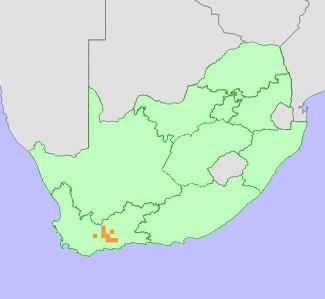|
Scientific Name | Conophytum joubertii Lavis |
Higher Classification | Dicotyledons |
Family | AIZOACEAE |
Synonyms | Conophytum viride Tischer |
National Status |
Status and Criteria | Endangered A3c |
Assessment Date | 2021/11/25 |
Assessor(s) | A.J. Young, P.G. Desmet, I. Ebrahim, D. Guo, A. Harrower, L. Jabar, L. Knoetze, C. Rodgerson, P.C.V. Van Wyk & N.N. Mhlongo |
Justification | This succulent is endemic to the Western Cape of South Africa with an extent of occurrence (EOO) of 690 km² and area of occupancy (AOO) of 24 km². Anthropogenic climate change is a major threat to this species. Whilst climate models predict a near-complete loss of 99% of suitable bioclimatic habitat by 2080 under likely emission scenario RCP 2.6, this species occurs across several vegetation units and is expected to show a level of resilience to climate change. Thus while model predictions place this species in the category Critically Endangered, the uncertainty of the response given the expected resilience of this species means the category due to climate change is downgraded to Endangered under criterion A3. |
Distribution |
Endemism | South African endemic |
Provincial distribution | Western Cape |
Range | This species is endemic to the Western Cape of South Africa. |
Habitat and Ecology |
Major system | Terrestrial |
Major habitats | Succulent Karoo |
Description | This species is endemic to the Rainshadow Valley Karoo in the Succulent Karoo biome. It is typically found as scattered individuals on lichen-covered shale but also on small patches of quartz. This species has a generation length of 30 years. It is expected to be sensitive to the impacts of climate change as it does not disperse and while adapted to arid conditions, is dependent on limited seasonal rainfall. Species in the genus are sensitive to long periods of drought. Drought related mortality has been observed for other closely related taxa within the genus. |
Threats |
| This particular species is not currently threatened by illegal collection but it is likely that it will become a target in coming years as there has been a dramatic increase in the number of species and volume of plants of this genus targeted since 2019. However, this is likely to affect less than 75% of the population due to the dispersed distribution of the species and large population size.
There is no decline in habitat quality for this species as inferred by changes in vegetation cover determined from changes in Enhanced Vegetation Index (EVI) between 1984 and 2018 using Landsat data (Venter et al. 2020). While it is not possible to model the response of this species to climate change due to its restricted distribution, the average loss to climate change for two more widely distributed Conophytum species occurring within the same region is used as an indication of likely impact to this species. Climate models for the likely emission scenarios where emissions stay at present day levels (RCP 2.6) (Hausfather and Peters 2020) and worst case scenarios where emissions continue to increase during the 21st century (RCP 8.5) indicate that there will be a loss of suitable bioclimatic envelope of between 99% and 100% by 2080 for Conophytum taxa within the region. However, as this species occurs across several vegetation units it is expected to have a level of resilience to climate change and the expected population loss is reduced by 20% to 79%. Species in this genus have limited dispersal ability and migration to suitable habitats elsewhere is regarded as highly unlikely. |
Population |
This species is widespread across numerous locations where it is typically locally common. The population size is likely to be well in excess of 100,000 plants. The number of plants in this general area have been in decline in recent years due to an extended drought and the population may be in decline.
|
Population trend | Unknown |
Assessment History |
Taxon assessed |
Status and Criteria |
Citation/Red List version | | Conophytum joubertii Lavis | Least Concern | Raimondo et al. (2009) | |
Bibliography |
Hammer, S. 2002. Dumpling and his wife: New view of the genus Conophytum. EAE Creative Colour, Norwich.
Hammer, S.A. 1993. The genus Conophytum: A conograph. Succulent Plant Publications, Pretoria.
Hausfather, Z. and Peters, G.P. 2020. Emissions - the 'business as usual' story is misleading. Nature 577(618-620).
Opel, M.R. 2004. The rediscovery of Crassula alcicornis. Haseltonia 10:38-40.
|
Citation |
| Young, A.J., Desmet, P.G., Ebrahim, I., Guo, D., Harrower, A., Jabar, L., Knoetze, L., Rodgerson, C., Van Wyk, P.C.V. & Mhlongo, N.N. 2021. Conophytum joubertii Lavis. National Assessment: Red List of South African Plants version 2024.1. Accessed on 2025/10/29 |
 Comment on this assessment
Comment on this assessment


